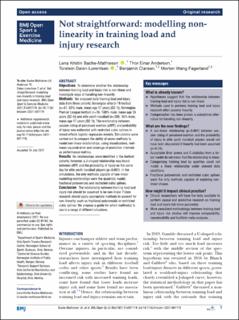Not straightforward: modelling non-linearity in training load and injury research
Bache-Mathiesen, Lena Kristin; Andersen, Thor Einar; Dalen-Lorentsen, Torstein; Clarsen, Benjamin Matthew; Fagerland, Morten
Peer reviewed, Journal article
Published version
Permanent lenke
https://hdl.handle.net/11250/3009367Utgivelsesdato
2021Metadata
Vis full innførselSamlinger
- Artikler [5061]
- Publikasjoner fra CRIStin FHI [7536]
Sammendrag
Objectives: To determine whether the relationship between training load and injury risk is non-linear and investigate ways of handling non-linearity. Methods: We analysed daily training load and injury data from three cohorts: Norwegian elite U-19 football (n=81, 55% male, mean age 17 years (SD 1)), Norwegian Premier League football (n=36, 100% male, mean age 26 years (SD 4)) and elite youth handball (n=205, 36% male, mean age 17 years (SD 1)). The relationship between session rating of perceived exertion (sRPE) and probability of injury was estimated with restricted cubic splines in mixed-effects logistic regression models. Simulations were carried out to compare the ability of seven methods to model non-linear relationships, using visualisations, root-mean-squared error and coverage of prediction intervals as performance metrics. Results: No relationships were identified in the football cohorts; however, a J-shaped relationship was found between sRPE and the probability of injury on the same day for elite youth handball players (p<0.001). In the simulations, the only methods capable of non-linear modelling relationships were the quadratic model, fractional polynomials and restricted cubic splines. Conclusion: The relationship between training load and injury risk should be assumed to be non-linear. Future research should apply appropriate methods to account for non-linearity, such as fractional polynomials or restricted cubic splines. We propose a guide for which method(s) to use in a range of different situations.
